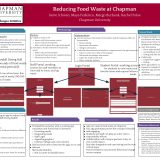
Artificial Intelligence and Improved Hardware Architecture GCI team aims to redesign the shape of the computer
April 26, 2021
The Grand Challenges Initiative (GCI) is the backbone of the first and second-year experience in the Schmid College of Science and Technology and the Fowler School of Engineering. Although the past year has brought many challenges, GCI teams are continuing to innovate from home. One sophomore team is finding ways to improve computer hardware design to accommodate energy-intensive artificial intelligence programs.
Blake Calvo ’23 (biochemistry and molecular biology), Jack Pauly ’23 (computer science), Ken Baierl ’23 (computer engineering), Patrick Hooverson ’23 (computer science), and Michael Efseaff ’23 (computer science) have always been interested in artificial intelligence. The GCI program gave them the opportunity to explore that interest more in-depth, and the group ultimately decided to focus on hardware aspects of computer design. After finishing literature reviews, the group decided to further narrow their focus to actually redesign the shape of the computer.
They said, “This worked well for us as all of our group members are adept with computer hardware. Most of our knowledge comes from experience or various YouTube tutorials, but Ken is majoring in computer hardware and that was absolutely a boon for our success. Our group’s current objective stemmed from Michael’s idea to change the structure of the computer itself, opting for an improved design that would maximize the ratio of surface area to used space. This design has since then morphed into what is currently being modeled in the SolidWorks program. Our current objective revolves around finishing the design in this new program and having it fabricated out of high-grade aluminum.”
All images are taken from an animation depicting an ideal version of their idea modeled and animated by Michael Efseaff ’23.

This image depicts what a single trapezoid may look like, each trapezoid is its own independent computing system, with cooling, power, and is externally covered with a mesh filter grill.

When six trapezoids are brought together it creates a hexagon, the 6 independent computing systems cluster together in order to improve computing power and efficiency. The center is where external cables, like a power cable, would enter and exit.
The cover photo shows the design when six trapezoids are brought together it creates a hexagon, the six independent computing systems cluster together in order to improve computing power and efficiency. The center is where external cables, like a power cable, would enter and exit.
As the group has moved forward with their project, they’ve been surprised to learn how far we are from the type of artificial intelligence seen in science fiction. Despite this, or perhaps because of it, the group continues to feel inspired to address challenges in the current development of AI. They also attribute their enthusiasm for the project to their particular group. Calvo explained, “Having the opportunity to work with a group that is so incredibly smart and motivated to see this project through has not only been exciting but a humbling experience. I look forward to all of my meetings with this group of guys, plus, tackling a challenge without a definite solution has been incredibly stimulating and exciting.” The group is also helped by the support from the GCI program itself. Solidworks, an advanced industry software, is the primary tool the group is using. Funding from GCI lets groups like this one have access to industry tools.
The group members have expressed that they plan to continue working on this project past the end of their time in GCI. Beyond that, all the group members have diverse career goals, from attending dental school to becoming a high school teacher.
The Team
- Blake Calvo ’23 (biochemistry and molecular biology)
- Jack Pauly ’23 (computer science)
- Ken Baierl ’23 (computer engineering)
- Michael Efseaff ’23 (computer science)
- Patrick Hooverson ’23 (computer science)
Blake Calvo’s goal is to enter into dental school and pursue a career in oral and maxillofacial surgery. He is interested in this kind of surgery because it lets him work with patients on a personal level, while also performing surgeries that are complex and challenging.
Jack Pauly is exploring careers but ultimately would like to combine his major in computer science and programming with his interest in digital design.
Ken Baierl would like to take this project as far as he can, but also wants to directly work on the components of a computer. This GCI team has helped Ken look more into computers and how they can work in different ways using different components.
Michael Efseaff wants to work in the game industry on either the engineering side or as a product manager. A dream of Michael’s since he was 8 years old has always been to develop a Star Wars game.
Patrick Hooverson would like to pursue a career in computer science. He also hopes to minor in psychology. As of now, he is thinking he would like to be a high school teacher, teaching math or computer science.






